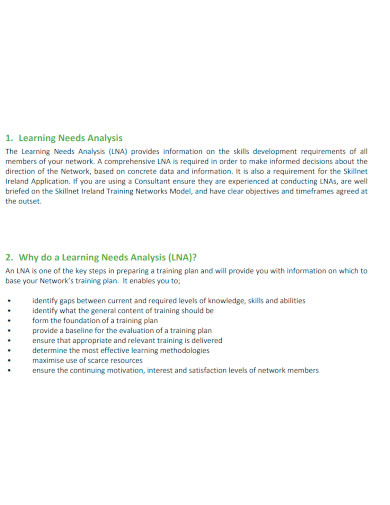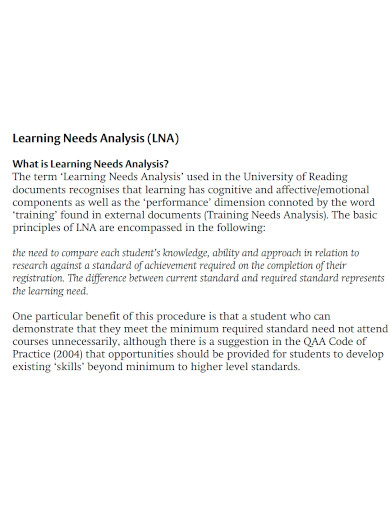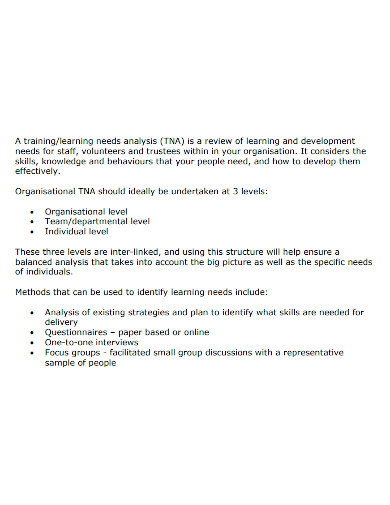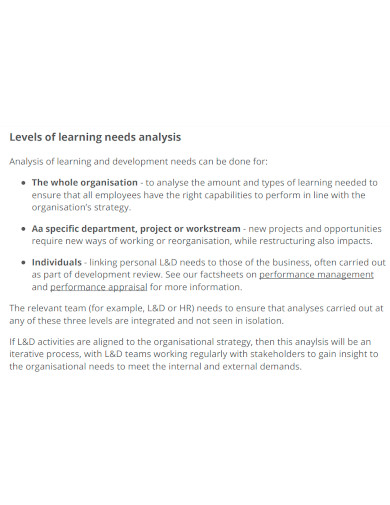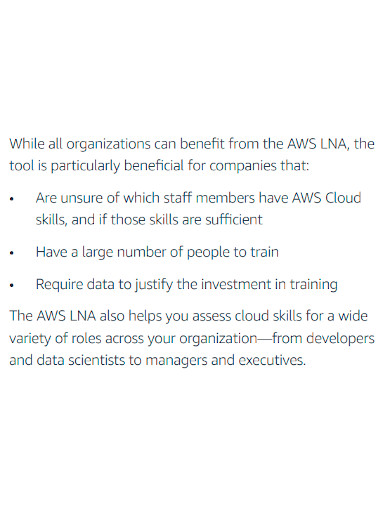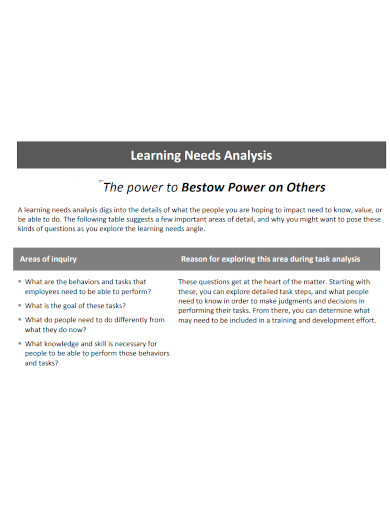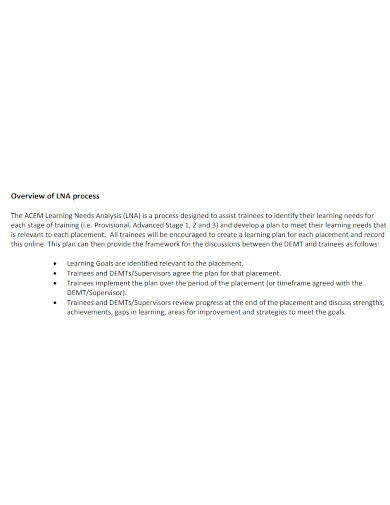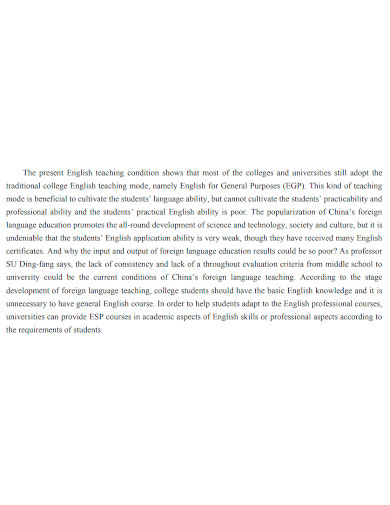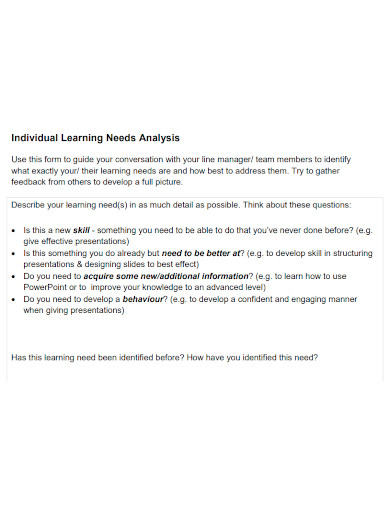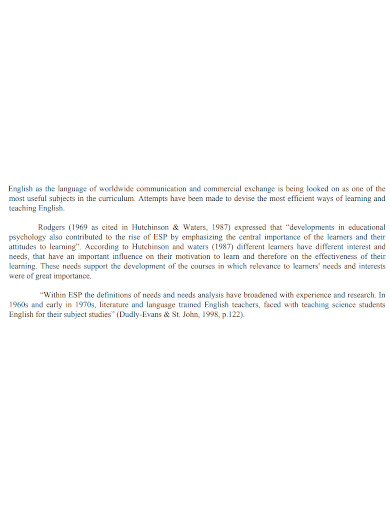Everyone has their flaw, even the most seasoned employees need to be taught and trained. When something new is introduced or even if there is a minor update in the system can create setbacks which is why companies need to invest in training and helping their employees learn if they want their business to grow and prosper. In order to get a full understanding of what training should be organized, then learning needs analysis should be conducted. This is in order to identify the different gaps an employee has or the team in general and help management make decisions on how to address such issues. To know more about this, let us discuss this further below. And if you need any templates, check out our free learning needs analysis samples that are downloadable on this page.
10+ Learning Needs Analysis Samples
1. Learning Needs Analysis Sample
2. Supervisors Learning Needs Analysis
3. Training or Learning Needs Analysis
4. Learning Needs Analysis Levels
5. Learning Needs Analysis Format
6. Professional Learning Needs Analysis
7. Editable Learning Needs Analysis
8. General Learning Needs Analysis
9. Basic Learning Needs Analysis
10. Individual Learning Needs Analysis
11. Strategic Learning Needs Analysis
What Is a Learning Needs Analysis?
In general, when you need to teach someone it is important to identify their needs, what they want or require to learn. By doing so you become aware of what needs to be addressed and that you may be able to efficiently find an effective approach. Even after finally graduating from school, we all are still in a constant state of learning even at work. That being said, an assessment is made towards an employee which can be conducted at any time but is often done after hiring, during performance reviews, when performance improvement is needed, for career development plans, for succession planning, or when changes in an organization also involve making necessary changes to employees’ jobs. And this assessment is in the form of learning needs analysis. This is to determine the gaps between the existing skills, knowledge, and abilities. Basically, an analysis is performed in order to help people improve their performance at work.
How To Conduct a Learning Needs Analysis?
The importance of conducting a learning needs analysis is not only to identify gaps but also to help management design effective training programs, and prepare the right budget and resources to implement these. Implementing training programs is an investment a company should undertake for its employees, so they must be sure that they are doing the right thing as to not waste the time, effort and money. So the need for the analysis is crucial in this stage, so how do you conduct one? Here are several steps to guide you.
I. Business Needs
Each company has its own unique business needs and goals. To be able to specifically identify these would help you understand better how the company works and what is needed from its employees. Since employees are the key to achieving a company’s goals, it is important that their work performance will be able to steer the company to success. Once that is established you are then able to identify what specific skills and knowledge are needed from the employee.
II. Gap Analysis
After assessing an employee’s work performance in terms of skills and knowledge, you will be able to determine the gaps in between. This process is called a gap analysis. There are various ways to perform this assessment such as checking an employee’s performance record and evaluations, or by performing interviews, written surveys or questionnaires or simply observing the employee.
III. Training Options
Now that you have determined the gaps, you need to address these issues by designing different training programs. Based on the data you have gathered will be able to generate a list of training options and needs. But this does not necessarily mean you can go ahead and conduct this training. Management must be able to also assess how reliable these training options are, in terms of budget, return of investment, and if all these can be an effective option to help employees learn and grow.
IV. Recommendation
Once you are able to map out the different training options, it is time to organize the training and learning plans for the employee(s). You need to provide recommendations to decision-makers backed up with solid data to prove why you have come up with these options and are able to align these learning goals to the company’s own goals. Present a report that should include a summary of why and how the assessment was completed, the methods used and people involved, and the training recommendations with a general timeline.
FAQs
What are the most common Employee Training Programs?
Some common training programs for employees are orientation training, sales, product, and leadership training.
Who Provides Company Training?
These are developed by the HR department, managers, outside trainers, or in-house consultants.
What are the Benefits of Training Employees?
If you want your company to grow, develop, and keep up with the latest trends then it is important to train your employees. A skilled and knowledgeable employee will help the company earn more profit and provide more business opportunities.
Although it may seem like a tedious process, a learning needs analysis is an important tool to help companies identify the gaps that may hinder an employee from performing better. Don’t forget to download our free templates to make it easier for you to conduct and prepare a learning needs analysis for your company.
Related Posts
FREE 10+ Analysis of Alternatives Samples in PDF
FREE 10+ Failure Mode and Effects Analysis Samples in PDF
FREE 10+ Make or Buy Analysis Samples in PDF
FREE 10+ Fishbone Root Cause Analysis Samples in PDF
FREE 11+ Cost Volume Profit Analysis Samples & Templates in PDF | MS Word
FREE 6+ Corporate Portfolio Analysis Samples in PDF
FREE 10+ Fault Tree Analysis Samples in PDF
FREE 10+ Comp Analysis Samples in PDF
FREE 10+ Fishbone Analysis Samples in PDF
FREE 10+ Individual Swot Analysis Samples in PDF
FREE 10+ 5 Year Analysis Samples in PDF
FREE 10+ Benefit Costs Analysis Samples in PDF
FREE 10+ Job Hazard Analysis Samples in PDF
FREE 10+ Primary Source Analysis Samples in PDF
FREE 10+ Critical Path Analysis Samples in PDF

